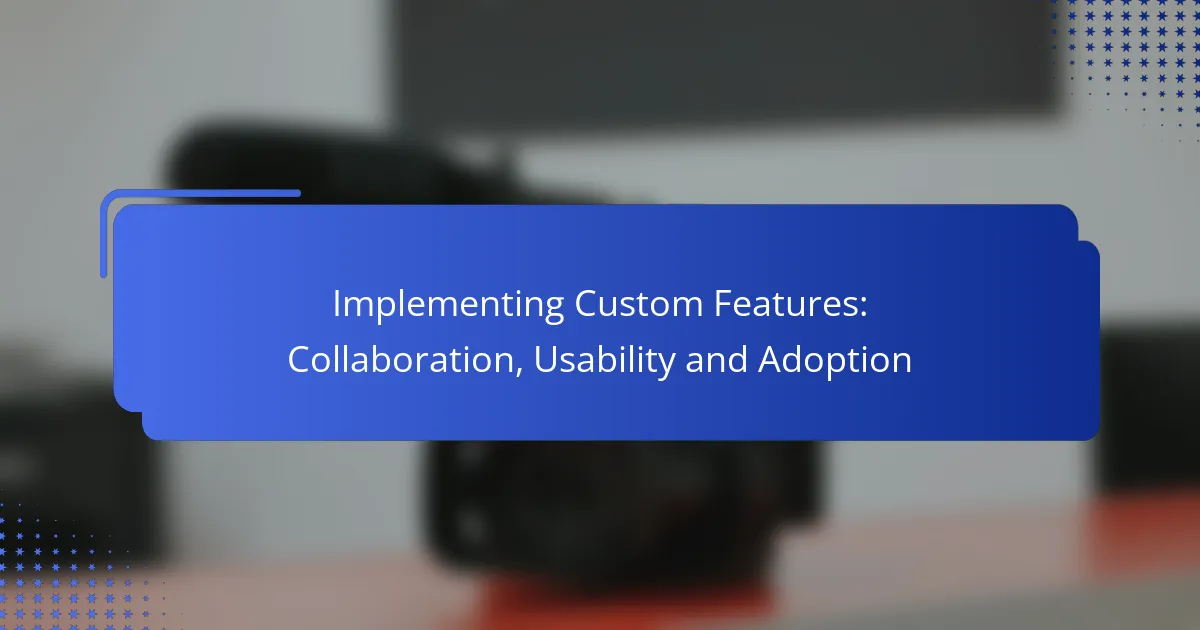Implementing custom features in SaaS tools requires a focus on user needs, iterative development, and continuous feedback to enhance usability and drive adoption. By fostering collaboration among team members and stakeholders, organizations can create user-centric features that resonate with a diverse audience. Key usability factors such as intuitive design and accessibility compliance are essential to ensure that all users can effectively engage with the new features.

What are the best practices for implementing custom features in SaaS tools?
Best practices for implementing custom features in SaaS tools focus on user needs, iterative development, and ongoing feedback. These strategies enhance usability, promote collaboration, and drive adoption among users.
User-centered design principles
User-centered design principles prioritize the needs and preferences of the end-users throughout the development process. This approach involves conducting user research, creating personas, and developing user journeys to ensure that features align with user expectations.
For effective implementation, engage users early through surveys or interviews to gather insights on their pain points and desired functionalities. Regular usability testing can help identify areas for improvement before the final launch.
Agile development methodologies
Agile development methodologies emphasize flexibility and iterative progress, allowing teams to adapt to changing requirements and user feedback. By breaking down the development process into smaller, manageable increments, teams can deliver features more quickly and efficiently.
Consider using frameworks like Scrum or Kanban to facilitate collaboration and maintain transparency among team members. This approach not only accelerates feature delivery but also fosters a culture of continuous improvement.
Continuous feedback loops
Continuous feedback loops involve regularly collecting and analyzing user feedback to refine features post-launch. This practice helps identify usability issues and areas for enhancement, ensuring that the tool remains relevant and effective.
Implement mechanisms such as in-app surveys, user analytics, and support channels to gather insights. Aim to establish a routine for reviewing feedback and making iterative updates, which can significantly boost user satisfaction and retention over time.

How can collaboration enhance feature adoption?
Collaboration significantly boosts feature adoption by fostering a shared understanding among team members and stakeholders. When diverse perspectives are integrated, it leads to more user-centric features that resonate with users, ultimately increasing their acceptance and usage.
Cross-functional team involvement
Involving cross-functional teams in the feature development process ensures that various expertise is represented, enhancing the quality and relevance of the features. For instance, including members from design, development, marketing, and customer support can provide insights that lead to more effective solutions.
To facilitate this, establish regular meetings where team members can share updates and feedback. This collaborative approach not only accelerates problem-solving but also builds a sense of ownership among team members, which can drive feature adoption.
Stakeholder engagement strategies
Engaging stakeholders early and often is crucial for successful feature adoption. This can involve conducting surveys, focus groups, or one-on-one interviews to gather input on feature development. By actively listening to stakeholders, you can align the features with their needs and expectations.
Additionally, consider creating a stakeholder advisory group that meets periodically to review progress and provide feedback. This ongoing engagement helps to maintain interest and support for the features being developed, increasing the likelihood of adoption.
Real-time collaboration tools
Utilizing real-time collaboration tools can streamline communication and enhance teamwork during the feature development process. Tools like Slack, Trello, or Asana allow team members to share updates, assign tasks, and track progress instantly, reducing delays and misunderstandings.
When selecting tools, prioritize those that integrate well with existing workflows and are user-friendly. Providing training sessions on these tools can also help team members feel more comfortable and engaged, further promoting collaboration and feature adoption.

What usability factors should be considered?
When implementing custom features, key usability factors include intuitive design, accessibility compliance, and performance optimization. These elements ensure that users can effectively interact with the features, regardless of their abilities or the devices they use.
Intuitive user interface design
An intuitive user interface (UI) design simplifies user interactions by making navigation clear and predictable. Essential elements include consistent layouts, recognizable icons, and logical workflows that guide users through tasks without confusion.
To enhance intuitiveness, consider conducting user testing sessions to gather feedback on design prototypes. Aim for a design that requires minimal training, allowing users to accomplish tasks quickly and efficiently.
Accessibility standards compliance
Compliance with accessibility standards, such as the Web Content Accessibility Guidelines (WCAG), ensures that your features are usable by individuals with disabilities. This includes providing text alternatives for non-text content, ensuring sufficient color contrast, and enabling keyboard navigation.
Incorporating accessibility from the beginning can prevent costly redesigns later. Regularly review your features against accessibility checklists and consider tools that simulate various disabilities to identify potential barriers.
Performance optimization techniques
Performance optimization is crucial for usability, as slow-loading features can frustrate users and lead to abandonment. Techniques include minimizing file sizes, optimizing images, and leveraging browser caching to improve load times.
Regularly monitor performance metrics, aiming for load times under two seconds for optimal user experience. Use tools like Google PageSpeed Insights to identify areas for improvement and implement changes based on user feedback.

What metrics indicate successful feature adoption?
Successful feature adoption can be measured through various metrics that reflect user interaction and satisfaction. Key indicators include user engagement rates, feature usage statistics, and customer satisfaction scores, each providing insights into how well a feature is integrated and valued by users.
User engagement rates
User engagement rates are crucial for assessing how actively users interact with a new feature. High engagement typically indicates that users find the feature useful and are incorporating it into their regular workflows. Tracking metrics such as daily active users (DAU) or session duration can provide a clear picture of engagement levels.
To improve user engagement, consider implementing onboarding tutorials or tooltips that guide users through the feature. Regularly soliciting feedback can also help identify barriers to engagement and areas for improvement.
Feature usage statistics
Feature usage statistics reveal how often and in what ways users are utilizing a feature. Metrics such as the frequency of use, the number of unique users, and the depth of feature interaction can highlight its effectiveness. For instance, if a feature is designed for daily tasks, a low usage rate may indicate that users are not finding it beneficial.
To enhance feature usage, analyze the data to identify patterns and adjust the feature accordingly. A/B testing different versions can also help determine which aspects resonate most with users, leading to increased adoption.
Customer satisfaction scores
Customer satisfaction scores, often gathered through surveys or feedback forms, provide direct insight into user perceptions of a feature. High satisfaction scores typically correlate with successful adoption, as satisfied users are more likely to continue using the feature and recommend it to others. Tools like Net Promoter Score (NPS) or Customer Satisfaction Score (CSAT) can be effective in measuring this.
To boost customer satisfaction, ensure that the feature aligns with user needs and expectations. Regularly updating users on improvements and actively responding to feedback can foster a positive relationship and enhance overall satisfaction.

What frameworks assist in evaluating custom feature needs?
Frameworks such as feature prioritization matrices and user journey mapping are essential for assessing custom feature requirements. They help teams identify, evaluate, and prioritize features based on user needs and business goals.
Feature prioritization matrix
A feature prioritization matrix is a tool that helps teams evaluate potential features based on criteria such as impact, effort, and alignment with strategic goals. By plotting features on a grid, teams can visually assess which features offer the most value relative to the resources required.
To create a prioritization matrix, list potential features along one axis and criteria along the other. Assign scores based on how well each feature meets the criteria, then calculate a total score to identify high-priority items. Common pitfalls include overcomplicating the criteria or failing to involve key stakeholders in the scoring process.
User journey mapping
User journey mapping is a technique that visualizes the steps users take to achieve a specific goal within a product. This framework helps identify pain points and opportunities for custom features that enhance user experience and engagement.
To create a user journey map, outline the stages users go through, from initial awareness to post-purchase support. Include user thoughts, feelings, and actions at each stage. This process can reveal gaps in current offerings and highlight features that could improve usability. Avoid making assumptions about user behavior; instead, gather data through user interviews or surveys for accurate insights.

How can user training improve feature adoption?
User training is essential for enhancing feature adoption as it equips users with the necessary skills and knowledge to effectively utilize new functionalities. By providing targeted training, organizations can significantly reduce resistance and increase user confidence, leading to higher engagement and productivity.
Onboarding programs
Onboarding programs are structured training initiatives designed to familiarize users with new features and tools. These programs typically include a combination of workshops, tutorials, and hands-on practice sessions that help users understand the benefits and functionalities of the features being introduced.
When designing an onboarding program, consider the specific needs of your users. Tailor the content to address common challenges and provide practical examples relevant to their daily tasks. For instance, if a new software tool is being implemented, include real-world scenarios that demonstrate how the tool can streamline workflows.
To maximize effectiveness, incorporate various learning methods, such as video tutorials, interactive sessions, and written guides. Regularly gather feedback to refine the onboarding experience and ensure it meets user expectations. Avoid overwhelming users with too much information at once; instead, break down the training into manageable segments that users can digest over time.
